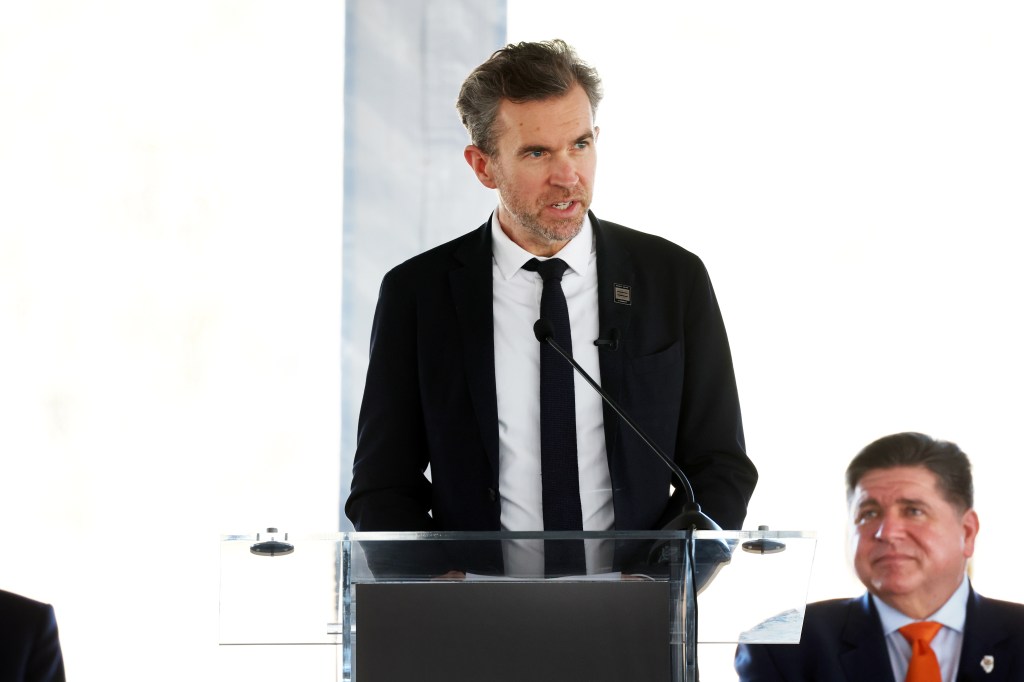Work has begun on the state’s new multibillion-dollar quantum computing campus on Chicago’s South Side. The lakefront site for the Illinois Quantum and Microelectronics Park was for decades U.S. Steel’s South Works, one of the world’s largest steel manufacturing plants, but will now host global companies seeking to develop the next generation of supercomputers.
Gov. JB Pritzker and others presided on Tuesday over the groundbreaking ceremony.
“Today we break ground on a landmark project that will establish Illinois as the nation’s leading hub for quantum innovation while attracting billions in economic investment and creating thousands of jobs,” Pritzker said in a statement. “With a growing roster of innovators calling IQMP home, we will position Illinois as the global leader in quantum innovation, unlocking new opportunities for scientific breakthroughs and economic advancement right here on the South Side.”
Pritzker has made establishing a quantum computing hub in Illinois a top priority for his administration. The state committed $500 million in 2024 toward the development of the lakefront quantum park, on top of $200 million in earlier investments into quantum computing.
California-based PsiQuantum agreed in 2024 to be the park’s anchor tenant. The company will eventually occupy a 300,000-square-foot facility near 87th Street and Lake Michigan where its researchers will build the first utility-scale quantum computer. Other tech firms, including IBM, Infleqtion and Diraq, some funded by the federal Defense Advanced Research Projects Agency, will also establish operations at the park.
Experts say next-generation quantum technology and advanced microelectronics will be far more powerful than present-day computers, and help make scientific discoveries in health care, energy, the climate crisis, transportation, financial services and agriculture.
“Ultimately, (a quantum computer) is a computer that solves big problems and solves them really fast,” said Harley Johnson, executive director and CEO of the Illinois Quantum and Microelectronics Park.
The growing ecosystem of firms at the lakefront site will also be a jobs engine for the entire South Side, he said. The nearby presence of top schools such as the University of Chicago, the University of Illinois Chicago and Northwestern University are big pluses for quantum researchers, but building and running a quantum complex requires more than software experts. It needs workers who understand precision machining and light manufacturing, and the Chicago region’s workforce is a big draw for the park’s tenants.
“Our workforce is always the first thing they mention,” Johnson said. “This is an industry that needs a supply chain that spans a pretty big range,” much like car manufacturers which attract auto parts suppliers. “That’s our hope and that’s what we expect.”
Johnson said the complex will bring in more computing firms as it develops over the next decade, many attracted by the Chicago region’s diverse economy and the potential to recruit local firms as customers.
“They want to be close by so they can build relationships with the companies they will do business with,” he said.
Curt Bailey, president of Related Midwest, the quantum park’s co-developer along with CRG, said the first phase will include building new roads and power infrastructure, along with an 80,000-square-foot structure for PsiQuantum. It will contain offices, computing spaces and a cryogenic facility that provides the extremely cold environments needed for quantum processors.
“We hope that will be followed up quickly with phases two, three, four and five,” he said. “This is a part of the city which hasn’t seen a lot of investment in the past 50 years, but by the end we foresee the investment into this project will be in the multiple of billions.”
The developers will still need City Council approvals for future plans, but Tuesday’s groundbreaking ends a decades-long struggle to find uses for the mostly vacant South Works site. It employed 20,000 people at its height, but when U.S. Steel shuttered it for good in 1992, only 700 remained. The plant was demolished, and a parade of developers hatched a series of unsuccessful schemes to replace it, including plans for up to 13,000 homes and a boat marina.
Bailey also envisions a new community rising near the 440-acre quantum site. The developers plan to construct new housing, retail and other business space along its western edge near South DuSable Lake Shore Drive.
“We are already deep into planning with local developers to build this housing,” he said.
The new quantum park will also extend the lakefront path, provide new walking trails, preserve native landscapes for wildlife, and incorporate the existing Steelworkers Park, including its 30-foot-tall ore walls, the last remnant of South Works, where docking ships would pour in tons of iron ore.
“The physical beauty of the site makes it a special place, and we want to respect that, not just for the neighbors, but for all Chicagoans,” Bailey said. “You’re really out in the middle of the lake, so it’s going to be a great place to work.”

